Photos by David Hey
ENGLISH ELECTRIC CO TYPE 4 (CLASS 40)
The first ten pilot-scheme Type 4s were a direct development of the SR trio Nos 10201-3, which were produced in collaboration with the EE Co between 1951-54. However, the BR locomotives more closely resembled that of the last Bulleid machine, No 10203, powered by the same 16SVT engine uprated to 2,000hp. Due to the weight of the bulky power equipment, the Type 4 was fitted with the rather cumbersome 1Co-Co1 bogie design made up of three motored wheels and an outer non-motored guiding axle to distribute its weight and reduce track wear. The buffers and associated drawgear was attached to the bogie frame, which was logical enough given the concomitant body overhang when the bogie pivots outwards. A gangway door was incorporated in the nose end to allow train crews access between locomotives when operating in multiple. Enginemen used doors like these on the underpowered LMS and SR prototypes, but rarely on the EE Co machines and they were subsequently dropped from D325 onwards in May 1961. The success of the ten EE Co Type 4s led to a production run of 190 locomotives, Nos D210-D399, all painted in BR Brunswick green livery, with a grey roof and a light grey shoulder band below the roof-mounted filter louvres. The earliest examples were also fitted with nose-front ladders to allow maintenance staff access to two hinged hatches on top of the nose, but these were discontinued for safety reasons when working in areas with overhead electrification equipment.
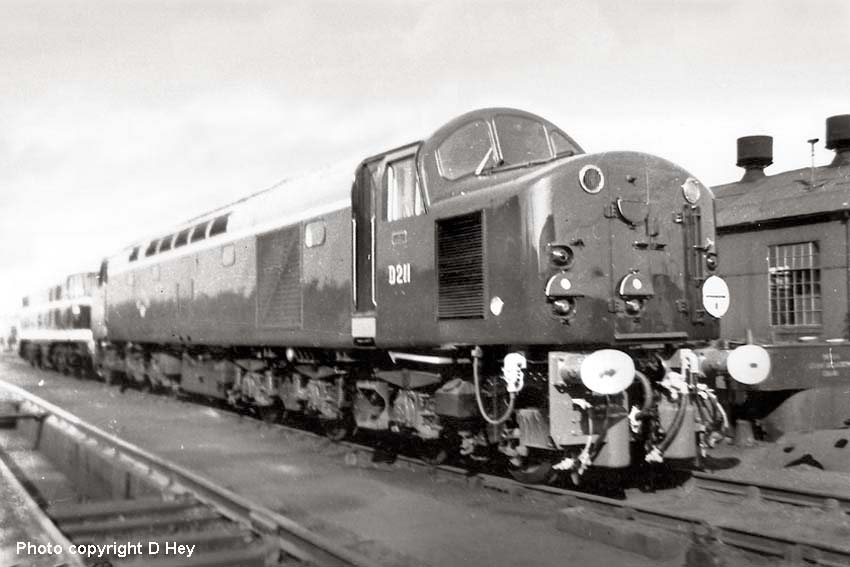
(Above) On the morning of May 23rd 1959 a friendly gateman at Doncaster Plant gave me permission to photograph a gleaming EE Co Type 4 No D211 (the second of the EE Co production batch destined for the LMR) and a Brush Type 2 No D5531 destined for ER - both standing outside the paintshop in view of the main entrance. What happened next is described on the Doncaster page 25 on the original site. Armed with a cheap Kodak Brownie 127, I took this shot of No D211 striking an impressive pose in its BR standard green livery, with a light grey shoulder band along the bodyside below the roof-mounted filter lovres. The BTC's specification for headcode disc displays to be incorporated on the nose end was used on Nos D200-324. The four discs could be used in various combinations to indicate the type of train being worked...in this case the single disc indicates a Freight, Mineral, or Ballast Train requiring to stop in between signal boxes (in the section) and Branch Freight Train.
(Below) The first EE Co Type 4s destined for the LMR were delivered between May and November 1959. They were allocated initially to Camden, Wiilesden, Crewe and Carlisle Upperby, then to Edge Hill and Longsight as deliveries proceeded. The LMR's first twenty five EE Co Type 4s, Nos D210-D235 (with the exception of D226) received names taken from famous ships belonging to the Canadian Pacific, Cunard and Elder Dempster Lines - all three companies being associated with sailings from the port of Liverpool. A named locomotive certainly added some much-needed panache to the early days of dieselisation. The EE Co's Type 4 No D211 - the second of the LMR's Camden batch, introduced to traffic in June 1959 - was named Mauretania by the Chairman of the Cunard Steamship Company at Liverpool Riverside in September 1960. Bearing the distinctive tartan-coloured 'Royal Scot' headboard, No D211 skims over Hest Bank troughs with the 'down' express on April 3rd 1961.

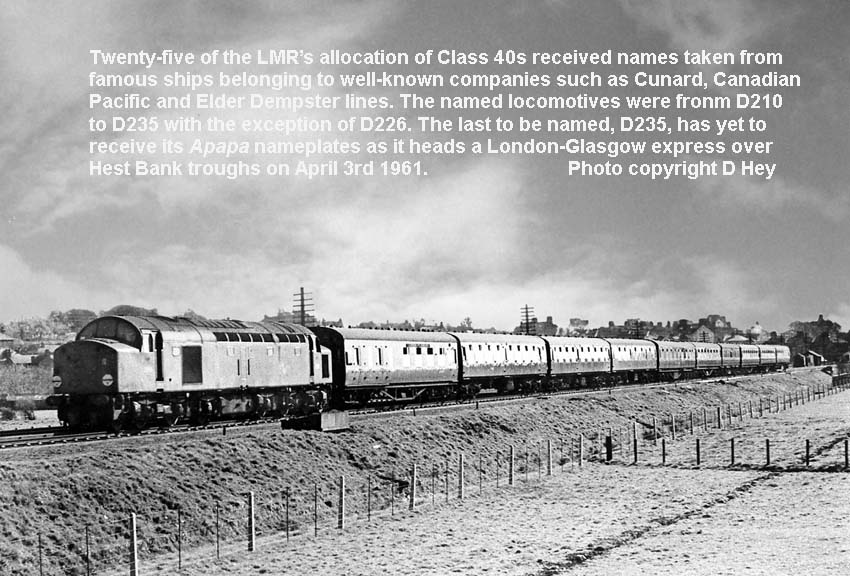
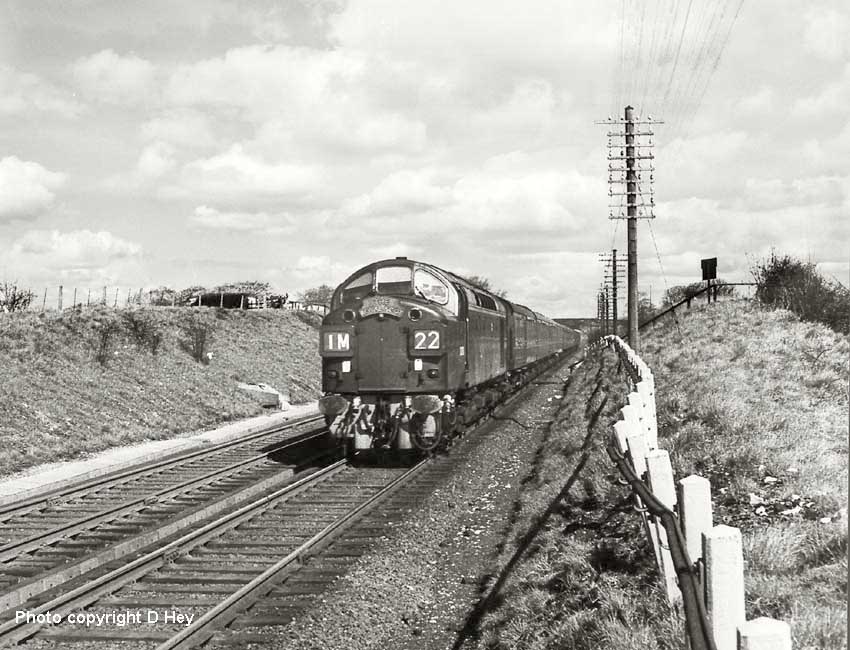
(Above) The LMR took delivery of its initial batch of EE Co's Type 4s Nos D210-D236 between May and November 1959. Nos D267-9/87-344 followed in 1960/61 - Nos D305-24 coming from the Robert Stephenson and Hawthorn works in Darlington. Finally, D369-84 arrived in 1961/62. The Type 4 fleet was soon employed on Anglo-Scottish trains, including the 'Royal Scot' often loaded to 14 bogies 510 tons gross. The original headcode disc displays gave way to four-character headcode boxes on either side of the nose on D325-D344, and a centrally positioned headcode panel on D345-D399. Here, the split-type route indicator boxes of No D326 displays 1M22 southbound 'Royal Scot' as it heads south at Hest Bank on April 3rd 1961.

(Above-Below) The steam heating boiler is definitely working as the driver applies power restarting a northbound train at Tebay...a standing start at the foot of the four-mile climb at 1 in 75 to Shao summit, which, on wet rails, was a sever haulage task without the ais of a banker. (Below) EE Co Type No D233 was allocated to Holyhead for crew training in November 1959. By the spring of the following year the EE Co machines became a regular sight on the North Wales Coast line, ousting in the process Holyhead's allocation of five 'Britannias' from 'Irish Mail' duties. Surprisingly, the EE Co Type 4's reign on the WCML's Anglo-Scottish service north of Crewe was not greatly affected by the more powerful 2,750hp Brush Type 4s, though the extra 750hp of the Brush machine made all the difference, particularly in the northern fells where speeds of 50mph could be regularly maintained on the climb over Shap. It was a significant improvement on the EE Co Type 4s which laboured at crawling pace over the summit. However, the LMR prefered reliability and familiarity in the maintenance of their EE Co machines, and it was not until the arrival of EE Co D400s in 1968 that the Class 40's reign was seriously affected north of Crewe. Here, No D233, later to be named Empress of England, heads a southbound train away from Dillicar troughs.
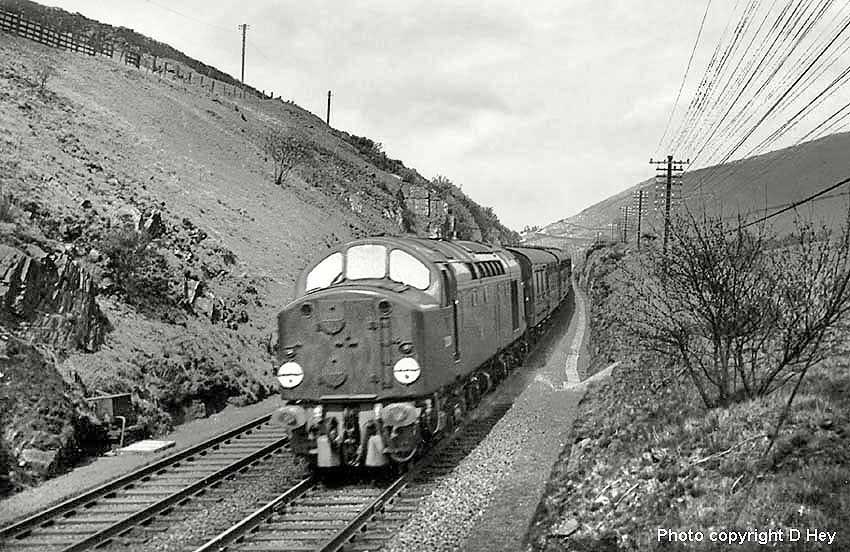
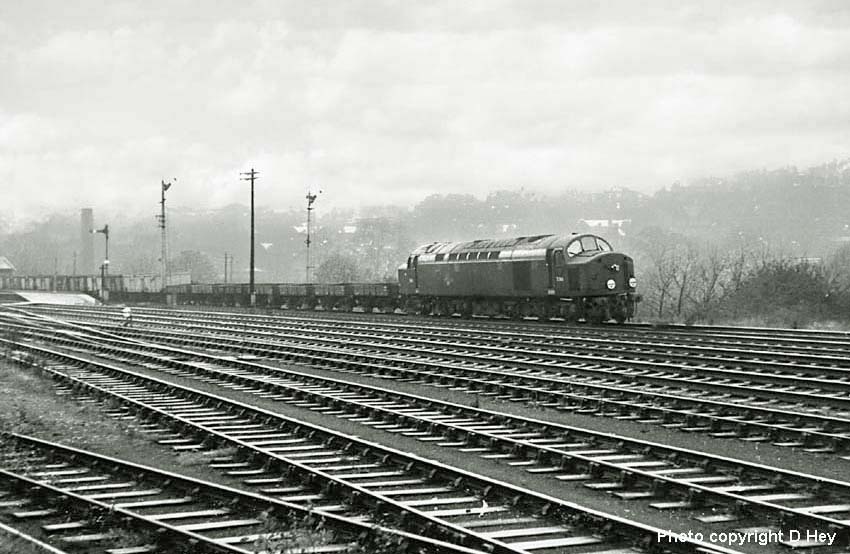
(Above-Below) Prior to the introduction of 'Peak' class Type 4 diesels on the Anglo-Scottish expresses north of Leeds, BR introduced an intensive crew training programme between Leeds and Appleby, involving train crewmen at Leeds Holbeck. Before diesel facilities were made available at Holbeck, BR Sulzer Type 4s Nos D11 and D14 were allocated temporarily to Leeds Neville Hill for the purpose. On occasions, however, an EE Co Type 4 power was borrowed for crew-training north of Leeds, such as York shed's No D254 (Above) seen here sporting a stencilled train reporting number N580 on its nose as it heads the return working (made up of a loose-coupled freight) to Leeds through Newlay & Horsforth staion in October 1960. (Below) York's D250 heads the more conventional train comprised of articulated coaching stock through Newlay Cutting in the same week. The train departed from Neville Hill at 9.30am - arriving at Appleby at 11.43 - departing at 12.55 for the return working to Leeds.



(Above) Divided allegiances...the new diesels may have been derided by older enthusiasts in the early days, yet they caused quite a stir amongst young spotters. As the transition from steam got into its stride, the enterprising English Electric Company became the only manufacturer to have designed and built diesel locomotives to meet the requirements of all five BR power classes. The company also supplied more than half of the diesel fleet. No D250 (introduced on the NE Region in December 1959) attracts a crowd of entusiasts at York on April 20th 1960.
(Below) With the number of EE Co's Type 4s gathering pace on the ECML, BR's Eastern and North Eastern Regions placed greater emphasis on the introduction of more efficient locomotive rosters to meet the increased demand for economies in rail operation. Given reasonable maintenance, a diesel locomotive's performance should be more accurately predicted than steam, but with the renewal of trackwork and signalling long overdue on the ECML, BR's timetable was made up of a depressing compilation of engineering slacks and therefore lavish recovery margins were incorporated into the timetable to allow train crews the chance to regain lost time. It wasn't until the ECML's outdated semaphore signalling was replaced by modern multiple aspect signalling (MAS) that any possibility of constant high-speed running could be fully exploited between Kings Cross and Newcastle, by which time the more powerful Type 5 'Deltics' had taken over the helm from the Type 4s. In this view, aged semaphores are much in evidence as No D256 heads an 'up' express through Temple Hirst station on the now-closed section of ECML south of Selby.

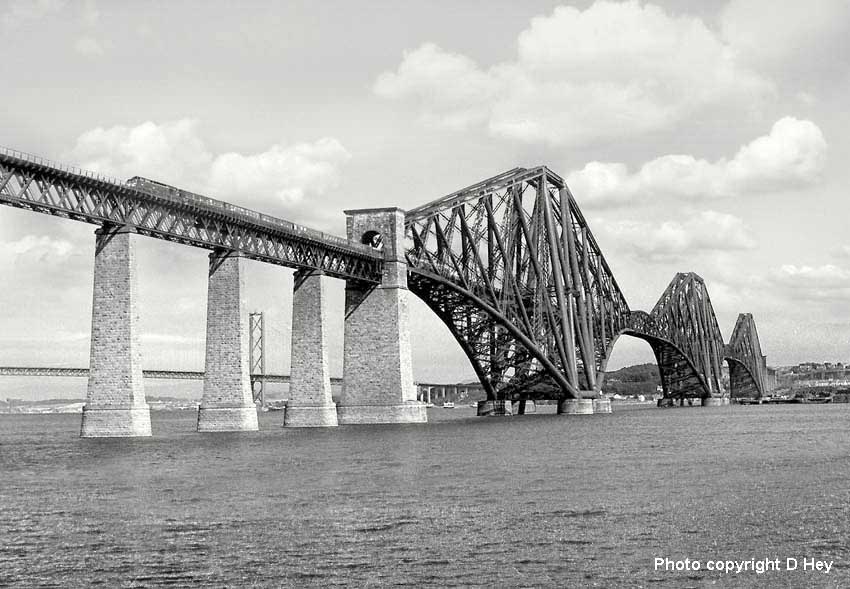
(Above-Below) It's difficult to compose a picture that captures the grandeur and style of a great railway bridge. I'd seen photographs of steam trains crossing the Forth Bridge in books and magazines, and wanted to see it for myself, but nothing quite prepared me for the overwhelming sense of wonder when I clapped eyes on the magnificent structure for the first time - the trains looked minuscule in comparison. The first shot is the traditional three-quarter view of the bridge and shows EE Co Type 4 No D264 heading an 'up' train in April 1964. The second shot shows D264 crossing the shoreline at South Queensferry. Behind the stone pier can be seen the Forth Road Bridge under construction and the ferryboat awaiting departure.

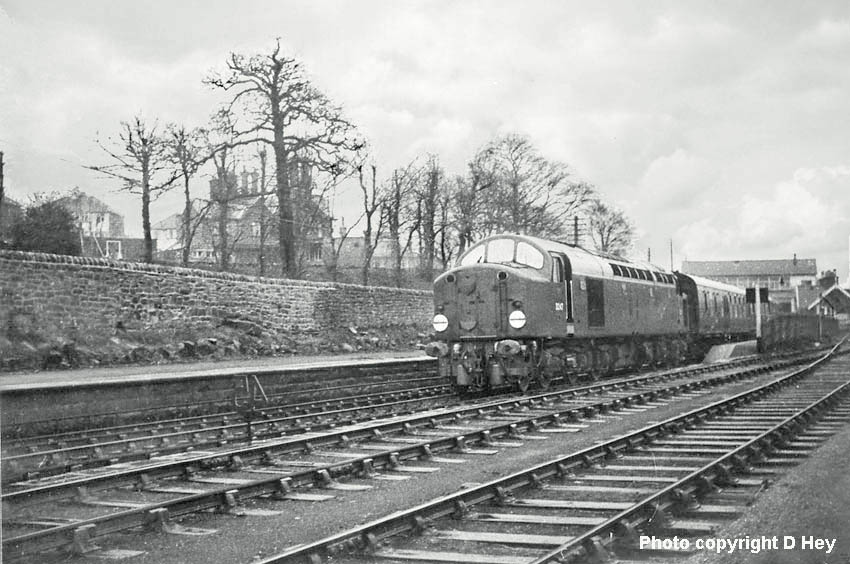
(Above) The rapid decline in the ranks of steam led to the EE Co Type 4s taking over many inter-Regional expresses on the MR and NER. During steam days, the Liverpool-Newcastle expresses were usually double-headed by a pair of 6Ps - Jubilee or Patriots - over the Standedge route across the Pennines, whilst a BR Standard 2-6-4T assisted a Class A3 Pacific over the steeply-graded line from Leeds to Harrogate. The Class 40s performed the task single-handed throughout. Here, No D247 heads a Liverpool-Newcastle train on the final leg of the 1 in 100 climb from Wortley Junction, Leeds to the summit just beyond Horsforth station in March 1960. Shortly after this photograph was taken most inter-Regional trains between Leeds and Harrogate were rerouted via the Wetherby line to avoid the untidy manoeuvre of reversal at Leeds. Before the end of the decade the Ripon line between Harrogate and Northallerton ceased as a through route when the majority of trains that used the line were re-routed via York. In 1967, all trains between Harrogate and Northallerton were withdrawn and the track lifted soon after, depriving the Cathedral city of Ripon of a direct link to the rail network and the important spa town of Harrogate stranded in the relative backwater of a branch line. (Below) Unidentified Class 40 heads a Liverpool-Newcastle train across the Leeds Ring Road at Woodside Horsforth in October 1960.

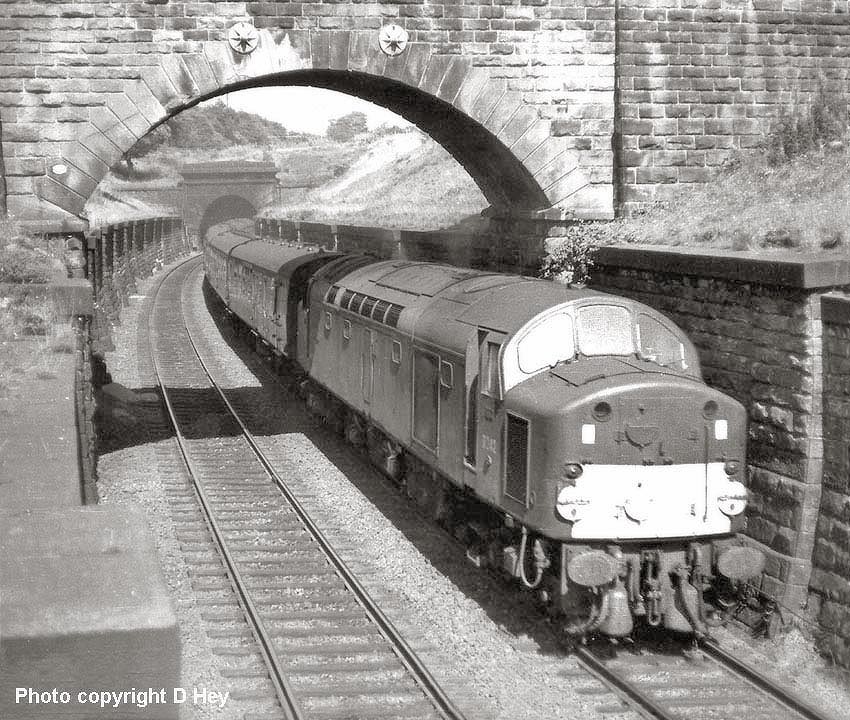
(Above-Below) At 2,000hp the EE Co Type 4s just qualified for the Type 4 category of 2,000-2,999hp (the BTC revised its original power classification of Type C - 2,000hp and upwards - to include a Type 5 of 3,000hp and upwards in its new diesel fleet). As loads increased on the ECML the EE Co machines were found to be underpowered for the fastest expresses, and they were subsequently displaced by the more powerful 47s and 'Deltics'. In January 1961, the EE Co machines found regular duties on the cross-country service between Mersyside and the North East. Here, EE Co Type 4 No D242 (retaining one handrail of the steps removed from the nose end) emerges from Bramhop Tunnel with the 15.16 Newcastle- Liverpool in June 1962. The train will reverse at Leeds New and take the standedge route across the Pennines. In the opposite direction, D250 gets to grips with a ruling gradient of 1 in 100 from Wortley Junction Leeds to the summit just beyond Horsforth station. In the background, Burley Viaduct - a popular venue for photographers of today's 'Scarborough Spa Express' specials - carries the Leeds Harrogate line over the Leeds-Liverpool Canal and River Aire out of the city.

(Below) I have included this 1980's view inside Thornaby Maintenance Depot in the hope of establishing what the 'box of tricks' is on the left. Even the Class 40 Preservation Society's 'Whistler' editor, Andy Sparks, is scratching his head. He kindly asked around for me, but came up with nothing. However, Diesel footplateman Fred Wagstaff contacted me - 'I would guess that the gear in the pit with all the gauges would be for measuring the tyre profiles, i.e. the amount of wear by the depth of the flange and the amount of wear on the face of the tyre angle to determine whether new tyres were needed, or if the originals could be re-profiled. However, this is pure guesswork. I never actually saw inside of Thornaby. Meanwhile, if anyone knows the answer, I'd dearly love to hear from them.

Mystery solved! Ex-BR Fleet Engineer, Vic Smith wrote in to say that the equipment in the pit adjacent to the class 40 is for weighing locomotives. When a locomotive had been involved in a derailment the BR Research staff from Derby used the equipment to check the individual wheel loadings to determine if they were correct or had contributed to the derailment. Vic also pointed me to an excellent website containing material processed by the New Zealand Electronic Text Centre of Victoria University, which features an article written by S. B. Barltrop, Production Draughtsman Hillside Workshops of the New Zealand Railways Department circa 1929. The article is beautifully written - clear, precise - and describes a similar piece of equipment associated with the weighing of locomotives before they are put into commission on the active service list. The object of weighing a locomotive is to ensure that each driving and bogie wheel of the machine carries its proper share of weight. Unequal distribution of weight means loss of tractive power, therefore specially designed weighing machines register the weights of the respective parts of the locomotive with the greatest accuracy. In cases where a locomotive has undergone repairs of a nature likely to have caused a change in the weight distribution, the closest attention is paid to the adjustments of the spring gear of the locomotive until the weights are correctly proportioned. Click here to read this interesting article. Thanks Vic...you haved bailed me out yet again!
BR DERBY/SULZER 'PEAK' TYPE 4
Early Days In Traffic
The BR Works at Derby was responsible for building the BTC's ten pilot scheme BR/Sulzer 2,300hp 1Co-Co1 numbered D1-D10 in the new diesel fleet. Introduced to traffic in 1959, the Type 4 'Peak' (later Class 44) was extremely heavy, turning the scale at more than 138 tons working weight, which necessitated the use of the cumbersome 1Co-Co1 wheel arrangement in order to distribute the load. The ten locomotives had the dubious distinction of being the heaviest of the pilot scheme designs, yet they had a neat appearance - the nose-end closely resembling that of the LMS pioneer Co-Cos Nos 10000-1 into which gangway doors were provided. All ten locomotives (Class 44) were named after Welsh or English mountains, and the name 'Peaks' was subsequently dubbed on the production models, 127 of which were ordered before the first pilot scheme batch had actually been completed. This headlong rush to oust steam meant that BR's new diesel fleet was acquired by a completely irrational process and, without the benefit of full prototype trials, several early types were quickly eliminated from BR stock. The 'Peaks', however, proved to be one of the more successful locomotives to appear subsequent to the pilot scheme orders.
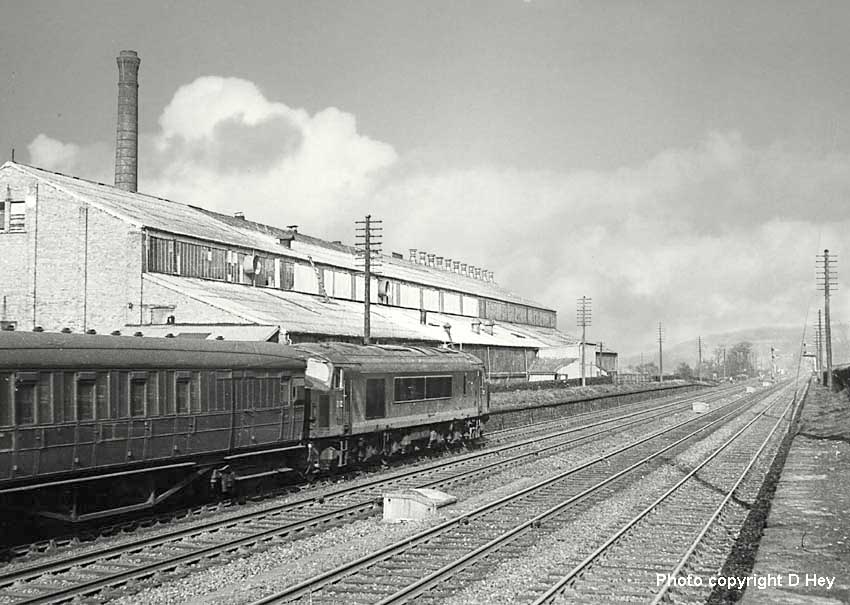
(Above) Prior to the introduction of 'Peak' class Type 4 diesels on the LMR's Anglo-Scottish expresses north of Leeds, BR introduced an intensive crew training programme between Leeds and Appleby, involving train crewmen at Leeds Holbeck. However, until diesel facilities were made available at Holbeck, a pair of BR Sulzer Type 4s Nos D11 and D14 was allocated temporarily to Leeds Neville Hill for the purpose. Here, D12 heads away from Shipley on the return working to Leeds on 9th March 1961. At this very same spot on the same day, I photographed Class A3 No 60092 Fairway heading the northbound 'Thames-Clyde Express' and 'Britannia' class 70054 Dornorch Firth heading the southbound 'Waverley'. For the record, No D12 (later Class 45 45011) was introduced to traffic in October 1960 and withdrawn in May 1981.
(Below) Sporting a stencilled train reporting number N580 on its nose, D14 (renumbered BR TOPS 45015) heads an interesting collection of articulated coaching stock through Apperley Bridge with the return working from Appleby to Leeds. The raking light picks out the three bodyside steps immediately behind the leading cab. With the introduction of modern coaching stock fitted with ETH (electric train heating) the old steam-heat boilers and water filling points on the 'Peaks' were removed from cantrail height and the 3 bodyside steps subsequently plated over. This was to prevent crewmen climbing up to roof level in areas with overhead electrification equipment.
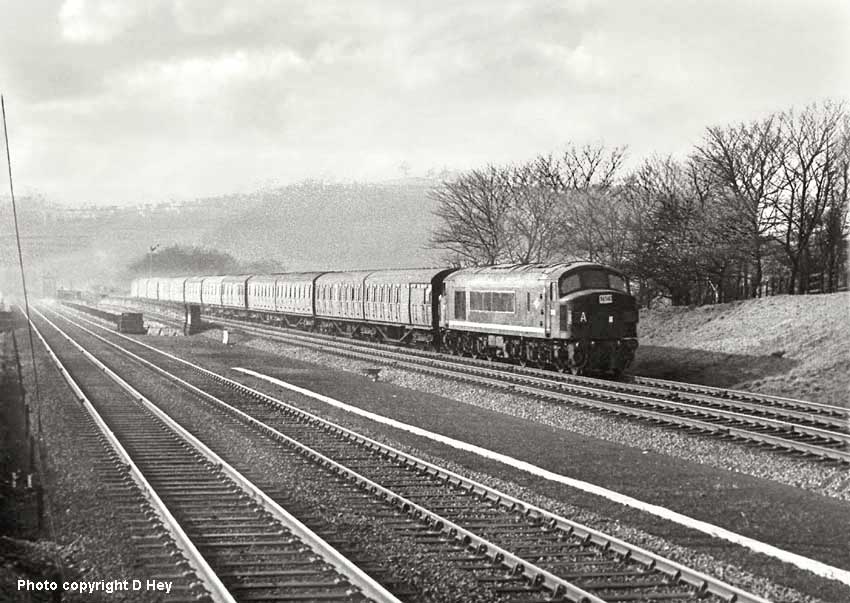
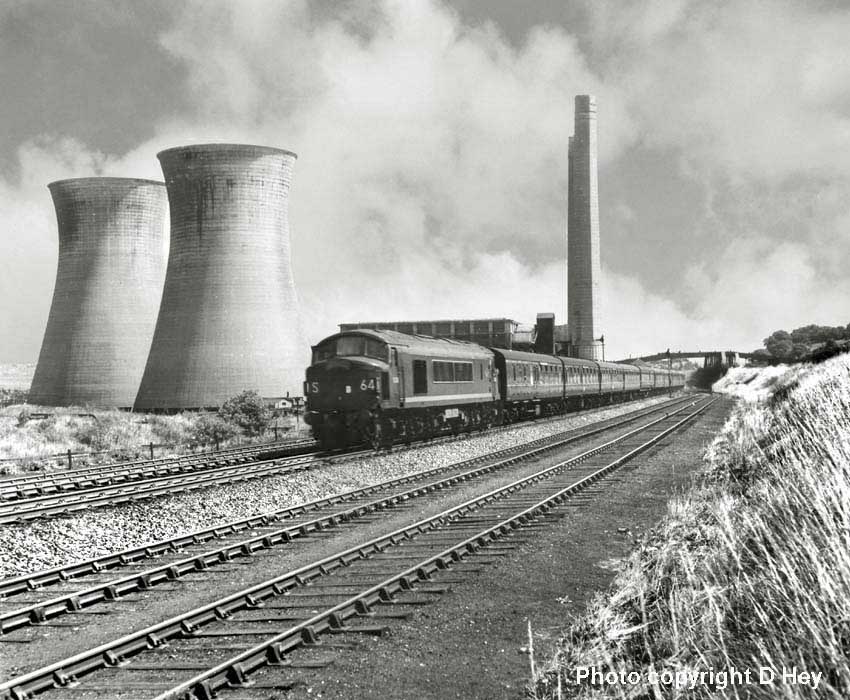
(Above-Below) The ten pilot scheme BR/Sulzer 'Peak' class Nos D1-D10 (Class 44) was followed by 183 production locomotives Nos D11-D193, all built at Crewe and Derby to the same basic design, but equipped with the more powerful Sulzer 12LDA28 'B' engine uprated to 2,500hp. Later to become known as Class 45, Nos D11-D137 were fitted with Crompton Parkinson electrical equipment,and Nos D138-D193 (later Class 46) had Brush electrical equipment fitted instead. Although the production Peaks were similar in appearance to the pilot scheme machines, some front end variations were incorporated when the gangway doors and white headcode discs were abandoned in favour of divided headcode boxes - one each side of the nose on Nos D11-31 and D68-107 - and a two-piece or solid route indicator panel centrally placed on the remaining locomotives. (Above) The Anglo-Scottish 'Waverley' and 'Thames-Clyde' expresses became diesel-hauled throughout from the start of the 1961 summer timetable. With the 'Waverley' headboard attached to the nose end, No D30 heads northbound past Kirkstall Power Staion in July 1961. (Below) In the opposite direction, an undentified 'Peak' heads the southbound 'Thames-Clyde Express' on 22 July 1961.

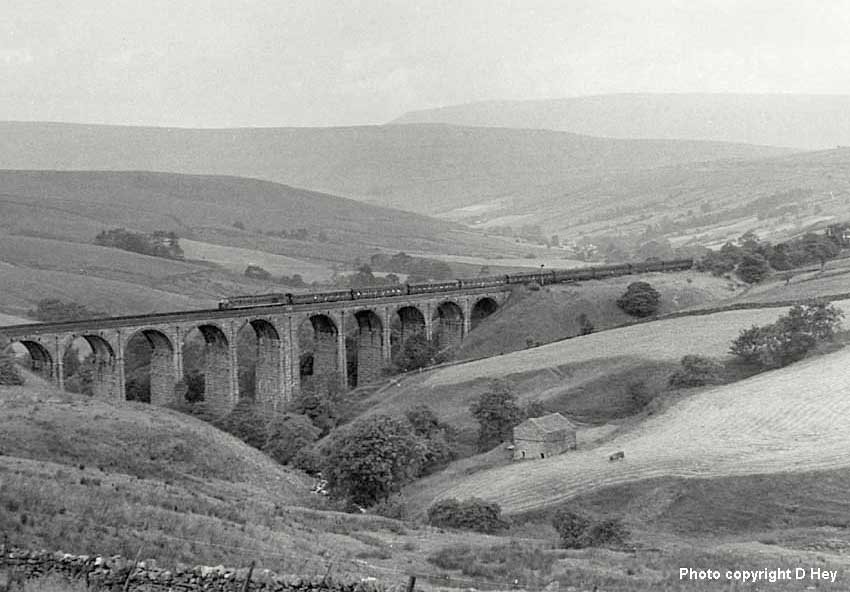
(Above) Following the first 10 pilot scheme 2,300hp Type 4 diesels Nos D1-D10, the production 'Peaks' were uprated to 2,500hp by use of charge air cooling, which gave rise to two genetic types of basically similar production locomotives - TOPS Class 45 and Class 46. An unidentified 'Peak' class heads a southbound train across Dent Head viaduct.
(Below) In 1961, British Railways abandoned the aged 'disc' display system for identifying trains (a legacy of steam days) in favour of a new four-character letter and numeral headcode display. The train classification, destination and identification system was introduced to assist signalmen - and it helped spotters too, as it happens! The headcodes consisted of a four-character display, the first numeral identifying the class of train, followed by a letter indicating the destination, whilst the next two digits represented the train reporting number. Back in the Sixties, a familiar train reporting number on my local line was 1S 68 - London-Leeds-Glasgow 'Thames-Clyde Express', which is displayed on No D? in August 1961. However, the system was later abandoned, since vibrations caused the numbers to revolve on their own accord, and the varying non-descriptive headcodes that appeared was a major factor for BR's decision to dispense with them entirely. From 1976, BR decreed that operating handles were to be removed and blinds set permanently at '0000', then during classified overhauls at Works the distinctive four-character headcode boxes were removed and two fixed-beam lamps were fitted on the nose.
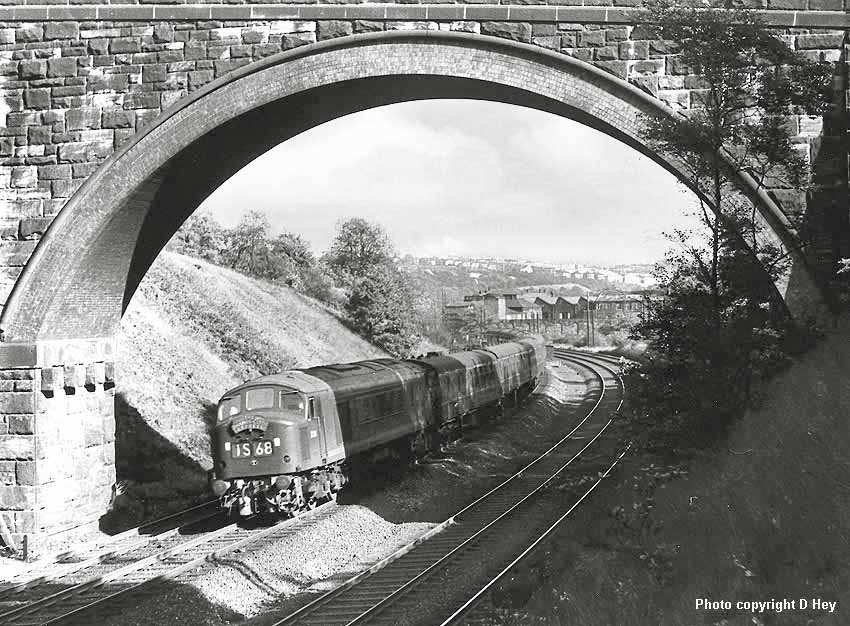
(Above-Below) The named train headboards added a certain panache to diesel-hauled expresses, but such extravagances were soon to disappear. The bulky 'Thames-Clyde' headboard did not sit easily on the top lamp iron of the 'Peak' class locomotives, as can be seen in this shot above of the train heading through Newlay Cutting. (Below) Fast-forward a few years and the headboard is missing on 'Peak' class No D147 (later 46010) heading the northbound express through Newlay Cutting in August 1965.
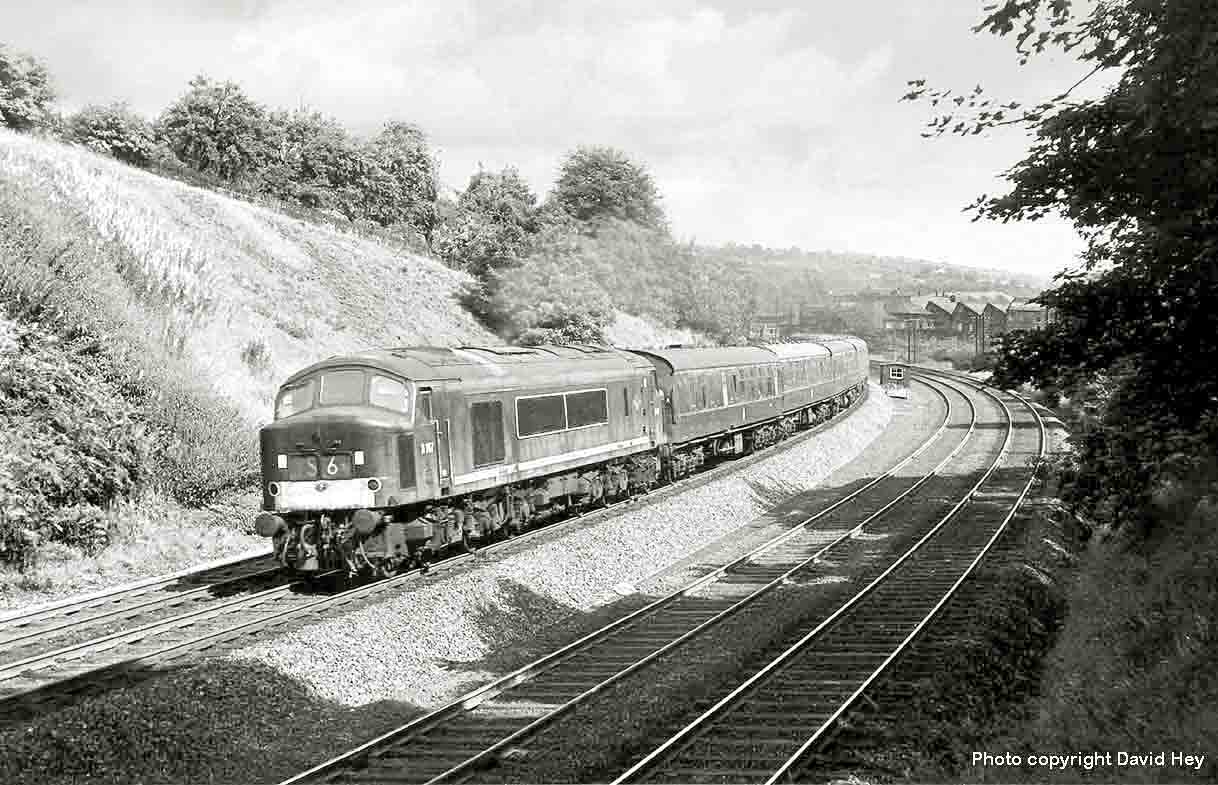

(Above-Below) D79 (later Class 45/0 45027 heads the nothbound 'Thames-Clyde Express through Calverly and Rodley. (Below) Crewe Works was responsible for building Nos D50-D137 in the fleet (Class 45). Here, the first of the batch, No D50 (later 45040) heads a uniform rake of Mk 1 coaching stock towards Leeds in Newlay Cutting in June 1964. The locomotive was later to be named King's Shropshire Light Infantry in May the following year. Incidentally, I am unable to fathom out the identification of this train…the headcode display reads 2D 85, but the single headlamp mounted on the top lamp-iron might indicate a failure of the roller blinds. Note also that both locomotives are sporting the compulsory rectangular yellow warning panels on the nose-end, although their effectiveness is somewhat marred by the centre position of the four-character headcode panel which restricts its size to the lower half of the nose.

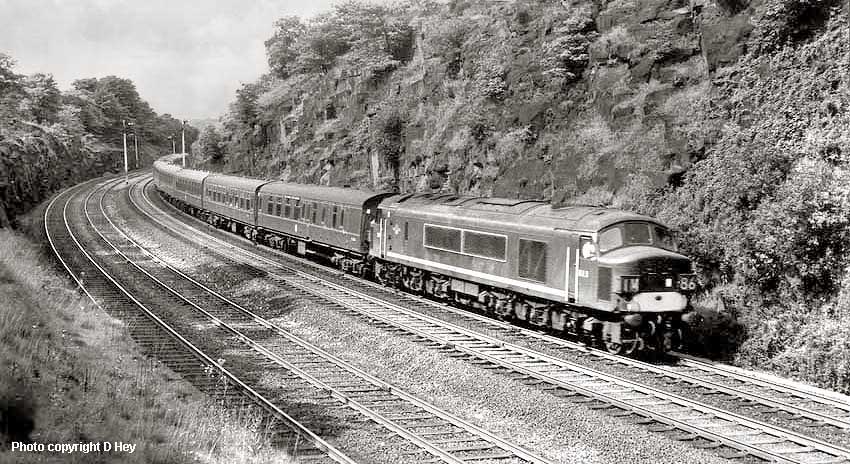

(Above-Below) The 183 production 'Peak' Type 4s were similar in appearance to the pilot scheme locomotives except for front end variations when the gangway doors and aged white headcode discs were abandoned in favour of route indicator panels. Striking an impressive pose at Holbeck shed is No D152 on the left with its panel centrally placed, wheras the earlier production 'Peaks' Nos D26 and D29 appear with divided headcode boxes either side of the nose. The reporting numbers are: 1M86 up 'Thames-Clyde Express', 1S49 10.25 Leeds-Glasgow and 0L50 light engine Leeds Division. Note also that Nos D26 and D29 are sporting a Holbeck 55A shed code on their rectangular warning panels. (Below) The rectangular yellow warning panel was standard through the 'Peak' series except for No D148 (later Class 46 46011) which was given a larger panel. No D148 heads a southbound express at Engine Shed Junction, Holbeck on 7 July 1963. In the background, Holbeck shed yard houses a fair complement of steam together with a pair of Class 25s and a solitary Class 03 shunter with its distinctive 'wasp' striped cab. The shed closed to steam on 30th September 1967, and three years later the roundhouse buildings and No 1 type coaling tower were demolished.
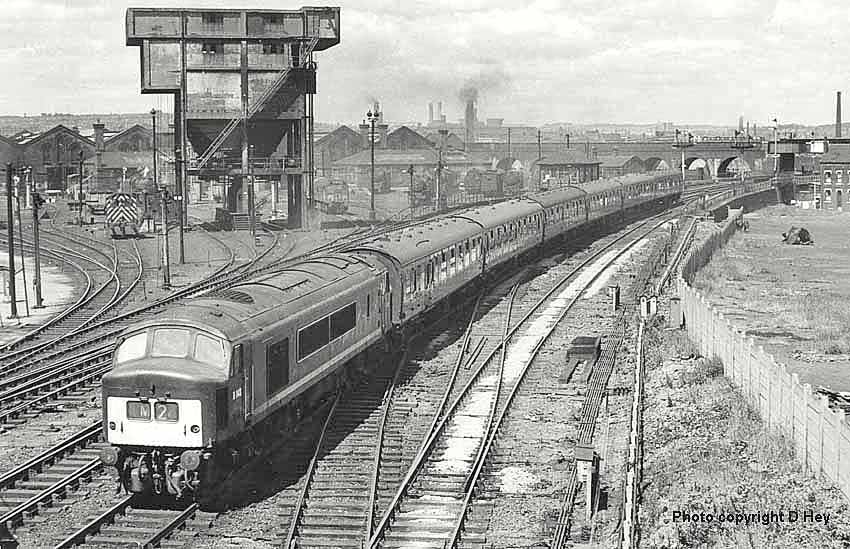
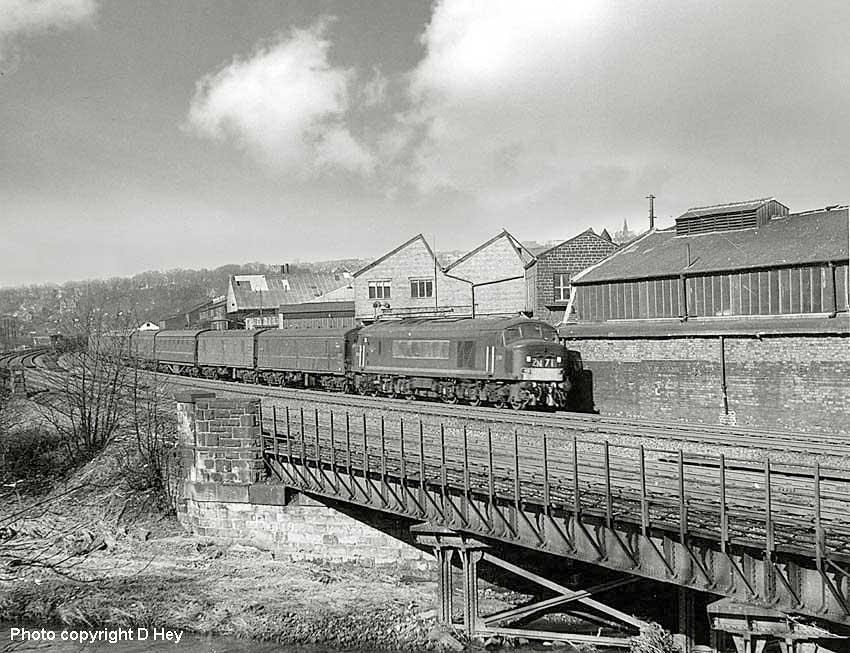
(Above-Below) The roller blind of D157 (later Class 46 No 46020) shows 2N71 on the 12.30 Morecambe to Leeds train on 28th May 1963. The train is crossing an 'S' bend of the River Aire at Kirkstall, Leeds. (Below) The bare branches of Autumn trees allows this colour shot of No D24 (later Class 45 No 45027) heading the southbound 'Thames-Clyde Express' in September 1963.
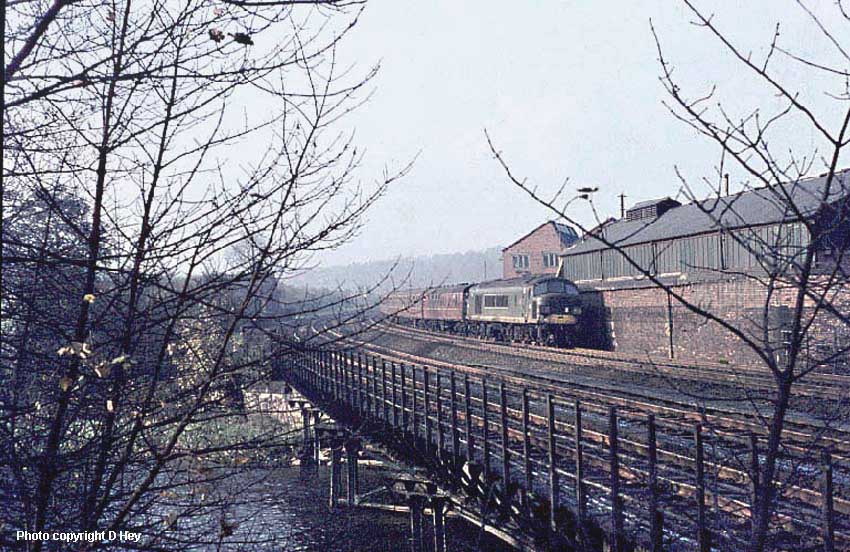
ENGLISH ELECTRIC CO TYPE 4 (CLASS 40)
The first ten pilot-scheme Type 4s were a direct development of the SR trio Nos 10201-3, which were produced in collaboration with the EE Co between 1951-54. However, the BR locomotives more closely resembled that of the last Bulleid machine, No 10203, powered by the same 16SVT engine uprated to 2,000hp. Due to the weight of the bulky power equipment, the Type 4 was fitted with the rather cumbersome 1Co-Co1 bogie design made up of three motored wheels and an outer non-motored guiding axle to distribute its weight and reduce track wear. The buffers and associated drawgear was attached to the bogie frame, which was logical enough given the concomitant body overhang when the bogie pivots outwards. A gangway door was incorporated in the nose end to allow train crews access between locomotives when operating in multiple. Enginemen used doors like these on the underpowered LMS and SR prototypes, but rarely on the EE Co machines and they were subsequently dropped from D325 onwards in May 1961. The success of the ten EE Co Type 4s led to a production run of 190 locomotives, Nos D210-D399, all painted in BR Brunswick green livery, with a grey roof and a light grey shoulder band below the roof-mounted filter louvres. The earliest examples were also fitted with nose-front ladders to allow maintenance staff access to two hinged hatches on top of the nose, but these were discontinued for safety reasons when working in areas with overhead electrification equipment.

(Above) On the morning of May 23rd 1959 a friendly gateman at Doncaster Plant gave me permission to photograph a gleaming EE Co Type 4 No D211 (the second of the EE Co production batch destined for the LMR) and a Brush Type 2 No D5531 destined for ER - both standing outside the paintshop in view of the main entrance. What happened next is described on the Doncaster page 25 on the original site. Armed with a cheap Kodak Brownie 127, I took this shot of No D211 striking an impressive pose in its BR standard green livery, with a light grey shoulder band along the bodyside below the roof-mounted filter lovres. The BTC's specification for headcode disc displays to be incorporated on the nose end was used on Nos D200-324. The four discs could be used in various combinations to indicate the type of train being worked...in this case the single disc indicates a Freight, Mineral, or Ballast Train requiring to stop in between signal boxes (in the section) and Branch Freight Train.
(Below) The first EE Co Type 4s destined for the LMR were delivered between May and November 1959. They were allocated initially to Camden, Wiilesden, Crewe and Carlisle Upperby, then to Edge Hill and Longsight as deliveries proceeded. The LMR's first twenty five EE Co Type 4s, Nos D210-D235 (with the exception of D226) received names taken from famous ships belonging to the Canadian Pacific, Cunard and Elder Dempster Lines - all three companies being associated with sailings from the port of Liverpool. A named locomotive certainly added some much-needed panache to the early days of dieselisation. The EE Co's Type 4 No D211 - the second of the LMR's Camden batch, introduced to traffic in June 1959 - was named Mauretania by the Chairman of the Cunard Steamship Company at Liverpool Riverside in September 1960. Bearing the distinctive tartan-coloured 'Royal Scot' headboard, No D211 skims over Hest Bank troughs with the 'down' express on April 3rd 1961.



(Above) The LMR took delivery of its initial batch of EE Co's Type 4s Nos D210-D236 between May and November 1959. Nos D267-9/87-344 followed in 1960/61 - Nos D305-24 coming from the Robert Stephenson and Hawthorn works in Darlington. Finally, D369-84 arrived in 1961/62. The Type 4 fleet was soon employed on Anglo-Scottish trains, including the 'Royal Scot' often loaded to 14 bogies 510 tons gross. The original headcode disc displays gave way to four-character headcode boxes on either side of the nose on D325-D344, and a centrally positioned headcode panel on D345-D399. Here, the split-type route indicator boxes of No D326 displays 1M22 southbound 'Royal Scot' as it heads south at Hest Bank on April 3rd 1961.

(Above-Below) The steam heating boiler is definitely working as the driver applies power restarting a northbound train at Tebay...a standing start at the foot of the four-mile climb at 1 in 75 to Shao summit, which, on wet rails, was a sever haulage task without the ais of a banker. (Below) EE Co Type No D233 was allocated to Holyhead for crew training in November 1959. By the spring of the following year the EE Co machines became a regular sight on the North Wales Coast line, ousting in the process Holyhead's allocation of five 'Britannias' from 'Irish Mail' duties. Surprisingly, the EE Co Type 4's reign on the WCML's Anglo-Scottish service north of Crewe was not greatly affected by the more powerful 2,750hp Brush Type 4s, though the extra 750hp of the Brush machine made all the difference, particularly in the northern fells where speeds of 50mph could be regularly maintained on the climb over Shap. It was a significant improvement on the EE Co Type 4s which laboured at crawling pace over the summit. However, the LMR prefered reliability and familiarity in the maintenance of their EE Co machines, and it was not until the arrival of EE Co D400s in 1968 that the Class 40's reign was seriously affected north of Crewe. Here, No D233, later to be named Empress of England, heads a southbound train away from Dillicar troughs.


(Above-Below) Prior to the introduction of 'Peak' class Type 4 diesels on the Anglo-Scottish expresses north of Leeds, BR introduced an intensive crew training programme between Leeds and Appleby, involving train crewmen at Leeds Holbeck. Before diesel facilities were made available at Holbeck, BR Sulzer Type 4s Nos D11 and D14 were allocated temporarily to Leeds Neville Hill for the purpose. On occasions, however, an EE Co Type 4 power was borrowed for crew-training north of Leeds, such as York shed's No D254 (Above) seen here sporting a stencilled train reporting number N580 on its nose as it heads the return working (made up of a loose-coupled freight) to Leeds through Newlay & Horsforth staion in October 1960. (Below) York's D250 heads the more conventional train comprised of articulated coaching stock through Newlay Cutting in the same week. The train departed from Neville Hill at 9.30am - arriving at Appleby at 11.43 - departing at 12.55 for the return working to Leeds.



(Above) Divided allegiances...the new diesels may have been derided by older enthusiasts in the early days, yet they caused quite a stir amongst young spotters. As the transition from steam got into its stride, the enterprising English Electric Company became the only manufacturer to have designed and built diesel locomotives to meet the requirements of all five BR power classes. The company also supplied more than half of the diesel fleet. No D250 (introduced on the NE Region in December 1959) attracts a crowd of entusiasts at York on April 20th 1960.
(Below) With the number of EE Co's Type 4s gathering pace on the ECML, BR's Eastern and North Eastern Regions placed greater emphasis on the introduction of more efficient locomotive rosters to meet the increased demand for economies in rail operation. Given reasonable maintenance, a diesel locomotive's performance should be more accurately predicted than steam, but with the renewal of trackwork and signalling long overdue on the ECML, BR's timetable was made up of a depressing compilation of engineering slacks and therefore lavish recovery margins were incorporated into the timetable to allow train crews the chance to regain lost time. It wasn't until the ECML's outdated semaphore signalling was replaced by modern multiple aspect signalling (MAS) that any possibility of constant high-speed running could be fully exploited between Kings Cross and Newcastle, by which time the more powerful Type 5 'Deltics' had taken over the helm from the Type 4s. In this view, aged semaphores are much in evidence as No D256 heads an 'up' express through Temple Hirst station on the now-closed section of ECML south of Selby.


(Above-Below) It's difficult to compose a picture that captures the grandeur and style of a great railway bridge. I'd seen photographs of steam trains crossing the Forth Bridge in books and magazines, and wanted to see it for myself, but nothing quite prepared me for the overwhelming sense of wonder when I clapped eyes on the magnificent structure for the first time - the trains looked minuscule in comparison. The first shot is the traditional three-quarter view of the bridge and shows EE Co Type 4 No D264 heading an 'up' train in April 1964. The second shot shows D264 crossing the shoreline at South Queensferry. Behind the stone pier can be seen the Forth Road Bridge under construction and the ferryboat awaiting departure.


(Above) The rapid decline in the ranks of steam led to the EE Co Type 4s taking over many inter-Regional expresses on the MR and NER. During steam days, the Liverpool-Newcastle expresses were usually double-headed by a pair of 6Ps - Jubilee or Patriots - over the Standedge route across the Pennines, whilst a BR Standard 2-6-4T assisted a Class A3 Pacific over the steeply-graded line from Leeds to Harrogate. The Class 40s performed the task single-handed throughout. Here, No D247 heads a Liverpool-Newcastle train on the final leg of the 1 in 100 climb from Wortley Junction, Leeds to the summit just beyond Horsforth station in March 1960. Shortly after this photograph was taken most inter-Regional trains between Leeds and Harrogate were rerouted via the Wetherby line to avoid the untidy manoeuvre of reversal at Leeds. Before the end of the decade the Ripon line between Harrogate and Northallerton ceased as a through route when the majority of trains that used the line were re-routed via York. In 1967, all trains between Harrogate and Northallerton were withdrawn and the track lifted soon after, depriving the Cathedral city of Ripon of a direct link to the rail network and the important spa town of Harrogate stranded in the relative backwater of a branch line. (Below) Unidentified Class 40 heads a Liverpool-Newcastle train across the Leeds Ring Road at Woodside Horsforth in October 1960.


(Above-Below) At 2,000hp the EE Co Type 4s just qualified for the Type 4 category of 2,000-2,999hp (the BTC revised its original power classification of Type C - 2,000hp and upwards - to include a Type 5 of 3,000hp and upwards in its new diesel fleet). As loads increased on the ECML the EE Co machines were found to be underpowered for the fastest expresses, and they were subsequently displaced by the more powerful 47s and 'Deltics'. In January 1961, the EE Co machines found regular duties on the cross-country service between Mersyside and the North East. Here, EE Co Type 4 No D242 (retaining one handrail of the steps removed from the nose end) emerges from Bramhop Tunnel with the 15.16 Newcastle- Liverpool in June 1962. The train will reverse at Leeds New and take the standedge route across the Pennines. In the opposite direction, D250 gets to grips with a ruling gradient of 1 in 100 from Wortley Junction Leeds to the summit just beyond Horsforth station. In the background, Burley Viaduct - a popular venue for photographers of today's 'Scarborough Spa Express' specials - carries the Leeds Harrogate line over the Leeds-Liverpool Canal and River Aire out of the city.

(Below) I have included this 1980's view inside Thornaby Maintenance Depot in the hope of establishing what the 'box of tricks' is on the left. Even the Class 40 Preservation Society's 'Whistler' editor, Andy Sparks, is scratching his head. He kindly asked around for me, but came up with nothing. However, Diesel footplateman Fred Wagstaff contacted me - 'I would guess that the gear in the pit with all the gauges would be for measuring the tyre profiles, i.e. the amount of wear by the depth of the flange and the amount of wear on the face of the tyre angle to determine whether new tyres were needed, or if the originals could be re-profiled. However, this is pure guesswork. I never actually saw inside of Thornaby. Meanwhile, if anyone knows the answer, I'd dearly love to hear from them.

Mystery solved! Ex-BR Fleet Engineer, Vic Smith wrote in to say that the equipment in the pit adjacent to the class 40 is for weighing locomotives. When a locomotive had been involved in a derailment the BR Research staff from Derby used the equipment to check the individual wheel loadings to determine if they were correct or had contributed to the derailment. Vic also pointed me to an excellent website containing material processed by the New Zealand Electronic Text Centre of Victoria University, which features an article written by S. B. Barltrop, Production Draughtsman Hillside Workshops of the New Zealand Railways Department circa 1929. The article is beautifully written - clear, precise - and describes a similar piece of equipment associated with the weighing of locomotives before they are put into commission on the active service list. The object of weighing a locomotive is to ensure that each driving and bogie wheel of the machine carries its proper share of weight. Unequal distribution of weight means loss of tractive power, therefore specially designed weighing machines register the weights of the respective parts of the locomotive with the greatest accuracy. In cases where a locomotive has undergone repairs of a nature likely to have caused a change in the weight distribution, the closest attention is paid to the adjustments of the spring gear of the locomotive until the weights are correctly proportioned. Click here to read this interesting article. Thanks Vic...you haved bailed me out yet again!
BR DERBY/SULZER 'PEAK' TYPE 4
Early Days In Traffic
The BR Works at Derby was responsible for building the BTC's ten pilot scheme BR/Sulzer 2,300hp 1Co-Co1 numbered D1-D10 in the new diesel fleet. Introduced to traffic in 1959, the Type 4 'Peak' (later Class 44) was extremely heavy, turning the scale at more than 138 tons working weight, which necessitated the use of the cumbersome 1Co-Co1 wheel arrangement in order to distribute the load. The ten locomotives had the dubious distinction of being the heaviest of the pilot scheme designs, yet they had a neat appearance - the nose-end closely resembling that of the LMS pioneer Co-Cos Nos 10000-1 into which gangway doors were provided. All ten locomotives (Class 44) were named after Welsh or English mountains, and the name 'Peaks' was subsequently dubbed on the production models, 127 of which were ordered before the first pilot scheme batch had actually been completed. This headlong rush to oust steam meant that BR's new diesel fleet was acquired by a completely irrational process and, without the benefit of full prototype trials, several early types were quickly eliminated from BR stock. The 'Peaks', however, proved to be one of the more successful locomotives to appear subsequent to the pilot scheme orders.

(Above) Prior to the introduction of 'Peak' class Type 4 diesels on the LMR's Anglo-Scottish expresses north of Leeds, BR introduced an intensive crew training programme between Leeds and Appleby, involving train crewmen at Leeds Holbeck. However, until diesel facilities were made available at Holbeck, a pair of BR Sulzer Type 4s Nos D11 and D14 was allocated temporarily to Leeds Neville Hill for the purpose. Here, D12 heads away from Shipley on the return working to Leeds on 9th March 1961. At this very same spot on the same day, I photographed Class A3 No 60092 Fairway heading the northbound 'Thames-Clyde Express' and 'Britannia' class 70054 Dornorch Firth heading the southbound 'Waverley'. For the record, No D12 (later Class 45 45011) was introduced to traffic in October 1960 and withdrawn in May 1981.
(Below) Sporting a stencilled train reporting number N580 on its nose, D14 (renumbered BR TOPS 45015) heads an interesting collection of articulated coaching stock through Apperley Bridge with the return working from Appleby to Leeds. The raking light picks out the three bodyside steps immediately behind the leading cab. With the introduction of modern coaching stock fitted with ETH (electric train heating) the old steam-heat boilers and water filling points on the 'Peaks' were removed from cantrail height and the 3 bodyside steps subsequently plated over. This was to prevent crewmen climbing up to roof level in areas with overhead electrification equipment.


(Above-Below) The ten pilot scheme BR/Sulzer 'Peak' class Nos D1-D10 (Class 44) was followed by 183 production locomotives Nos D11-D193, all built at Crewe and Derby to the same basic design, but equipped with the more powerful Sulzer 12LDA28 'B' engine uprated to 2,500hp. Later to become known as Class 45, Nos D11-D137 were fitted with Crompton Parkinson electrical equipment,and Nos D138-D193 (later Class 46) had Brush electrical equipment fitted instead. Although the production Peaks were similar in appearance to the pilot scheme machines, some front end variations were incorporated when the gangway doors and white headcode discs were abandoned in favour of divided headcode boxes - one each side of the nose on Nos D11-31 and D68-107 - and a two-piece or solid route indicator panel centrally placed on the remaining locomotives. (Above) The Anglo-Scottish 'Waverley' and 'Thames-Clyde' expresses became diesel-hauled throughout from the start of the 1961 summer timetable. With the 'Waverley' headboard attached to the nose end, No D30 heads northbound past Kirkstall Power Staion in July 1961. (Below) In the opposite direction, an undentified 'Peak' heads the southbound 'Thames-Clyde Express' on 22 July 1961.


(Above) Following the first 10 pilot scheme 2,300hp Type 4 diesels Nos D1-D10, the production 'Peaks' were uprated to 2,500hp by use of charge air cooling, which gave rise to two genetic types of basically similar production locomotives - TOPS Class 45 and Class 46. An unidentified 'Peak' class heads a southbound train across Dent Head viaduct.
(Below) In 1961, British Railways abandoned the aged 'disc' display system for identifying trains (a legacy of steam days) in favour of a new four-character letter and numeral headcode display. The train classification, destination and identification system was introduced to assist signalmen - and it helped spotters too, as it happens! The headcodes consisted of a four-character display, the first numeral identifying the class of train, followed by a letter indicating the destination, whilst the next two digits represented the train reporting number. Back in the Sixties, a familiar train reporting number on my local line was 1S 68 - London-Leeds-Glasgow 'Thames-Clyde Express', which is displayed on No D? in August 1961. However, the system was later abandoned, since vibrations caused the numbers to revolve on their own accord, and the varying non-descriptive headcodes that appeared was a major factor for BR's decision to dispense with them entirely. From 1976, BR decreed that operating handles were to be removed and blinds set permanently at '0000', then during classified overhauls at Works the distinctive four-character headcode boxes were removed and two fixed-beam lamps were fitted on the nose.

(Above-Below) The named train headboards added a certain panache to diesel-hauled expresses, but such extravagances were soon to disappear. The bulky 'Thames-Clyde' headboard did not sit easily on the top lamp iron of the 'Peak' class locomotives, as can be seen in this shot above of the train heading through Newlay Cutting. (Below) Fast-forward a few years and the headboard is missing on 'Peak' class No D147 (later 46010) heading the northbound express through Newlay Cutting in August 1965.


(Above-Below) D79 (later Class 45/0 45027 heads the nothbound 'Thames-Clyde Express through Calverly and Rodley. (Below) Crewe Works was responsible for building Nos D50-D137 in the fleet (Class 45). Here, the first of the batch, No D50 (later 45040) heads a uniform rake of Mk 1 coaching stock towards Leeds in Newlay Cutting in June 1964. The locomotive was later to be named King's Shropshire Light Infantry in May the following year. Incidentally, I am unable to fathom out the identification of this train…the headcode display reads 2D 85, but the single headlamp mounted on the top lamp-iron might indicate a failure of the roller blinds. Note also that both locomotives are sporting the compulsory rectangular yellow warning panels on the nose-end, although their effectiveness is somewhat marred by the centre position of the four-character headcode panel which restricts its size to the lower half of the nose.



(Above-Below) The 183 production 'Peak' Type 4s were similar in appearance to the pilot scheme locomotives except for front end variations when the gangway doors and aged white headcode discs were abandoned in favour of route indicator panels. Striking an impressive pose at Holbeck shed is No D152 on the left with its panel centrally placed, wheras the earlier production 'Peaks' Nos D26 and D29 appear with divided headcode boxes either side of the nose. The reporting numbers are: 1M86 up 'Thames-Clyde Express', 1S49 10.25 Leeds-Glasgow and 0L50 light engine Leeds Division. Note also that Nos D26 and D29 are sporting a Holbeck 55A shed code on their rectangular warning panels. (Below) The rectangular yellow warning panel was standard through the 'Peak' series except for No D148 (later Class 46 46011) which was given a larger panel. No D148 heads a southbound express at Engine Shed Junction, Holbeck on 7 July 1963. In the background, Holbeck shed yard houses a fair complement of steam together with a pair of Class 25s and a solitary Class 03 shunter with its distinctive 'wasp' striped cab. The shed closed to steam on 30th September 1967, and three years later the roundhouse buildings and No 1 type coaling tower were demolished.


(Above-Below) The roller blind of D157 (later Class 46 No 46020) shows 2N71 on the 12.30 Morecambe to Leeds train on 28th May 1963. The train is crossing an 'S' bend of the River Aire at Kirkstall, Leeds. (Below) The bare branches of Autumn trees allows this colour shot of No D24 (later Class 45 No 45027) heading the southbound 'Thames-Clyde Express' in September 1963.

Polite notice: All text and photographs are protected by copyright and reproduction is prohibited without the prior consent of the © owners. If you wish to discuss using the contents of this page the email address is below. Please note - this is not a 'clickable' mail-to link via Outlook Express. You will have to email manually.
dheycollection@ntlworld.com




